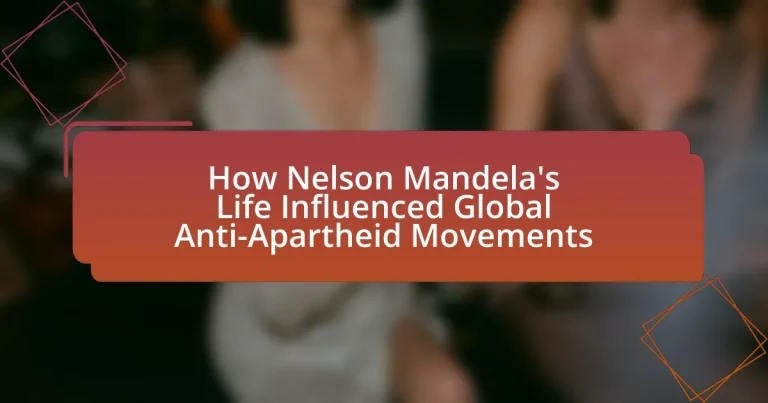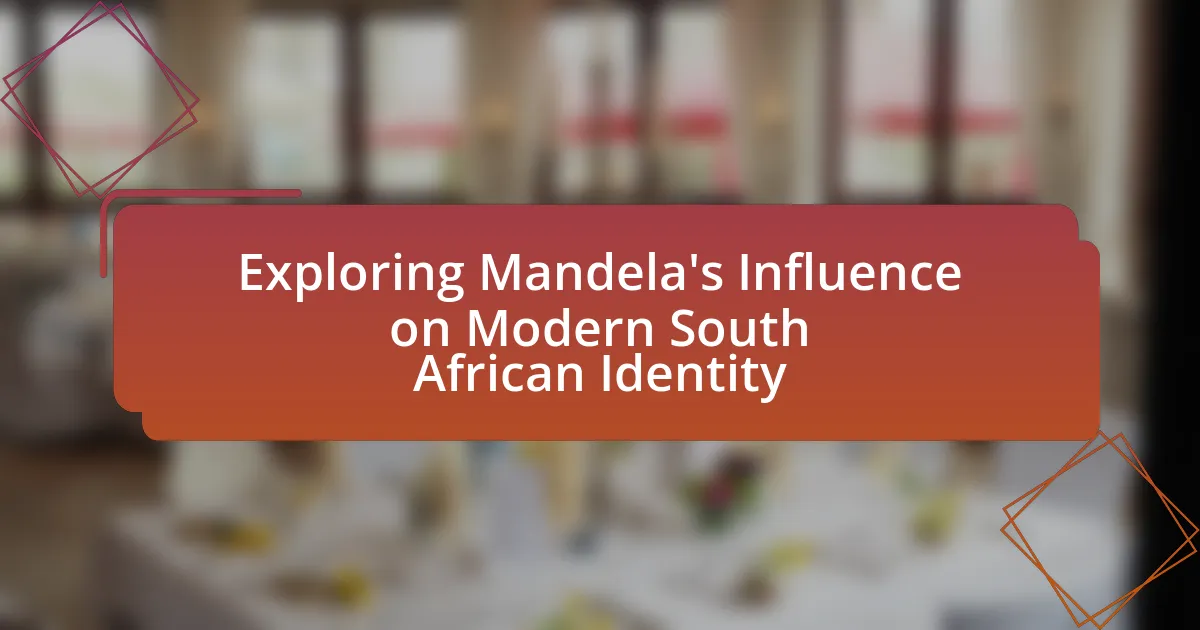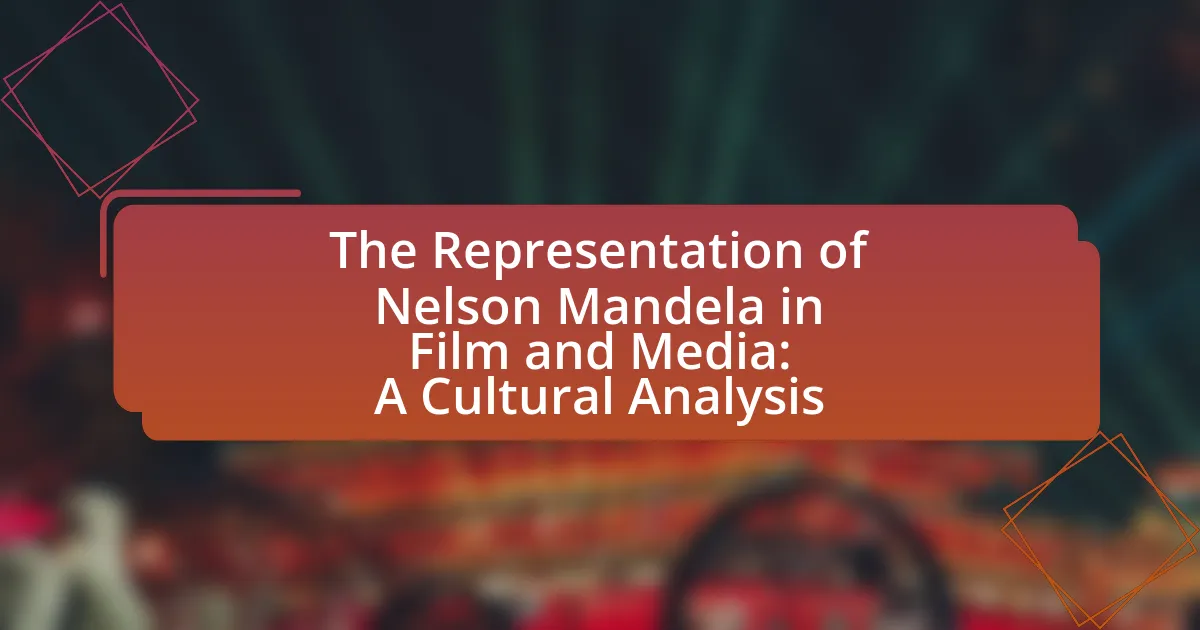Nelson Mandela’s life played a pivotal role in shaping global anti-apartheid movements, serving as a powerful symbol of resistance against racial oppression. His 27 years of imprisonment drew international attention to the injustices of apartheid, inspiring widespread activism and support for his cause. Key events in Mandela’s life, including his leadership in the African National Congress and his commitment to non-violent protest, significantly influenced both national and international efforts to dismantle apartheid. His emphasis on reconciliation and dialogue during the transition to democracy further solidified his legacy, demonstrating the effectiveness of peaceful activism in the pursuit of social justice. The article explores Mandela’s impact on global movements, the strategies he employed, and the lessons contemporary activists can learn from his life and work.
How did Nelson Mandela’s life shape the global anti-apartheid movements?
Nelson Mandela’s life significantly shaped global anti-apartheid movements by serving as a symbol of resistance against racial oppression and injustice. His 27 years of imprisonment highlighted the brutality of apartheid, galvanizing international support and activism against the South African regime. Mandela’s leadership in the African National Congress and his commitment to non-violent protest, as well as his later advocacy for reconciliation, inspired movements worldwide, leading to widespread boycotts, sanctions, and protests aimed at dismantling apartheid. The global outcry for his release and the eventual end of apartheid in 1994 underscored his impact, as countries rallied around his cause, demonstrating the power of individual agency in the fight for human rights.
What were the key events in Nelson Mandela’s life that influenced his activism?
Key events in Nelson Mandela’s life that influenced his activism include his involvement in the African National Congress (ANC) in 1944, his leadership role in the Defiance Campaign against apartheid laws in 1952, and his imprisonment for 27 years starting in 1962. Mandela’s early exposure to racial discrimination in his hometown of Mvezo and his education at the University of Fort Hare also shaped his political consciousness. His participation in the ANC’s armed wing, Umkhonto we Sizwe, marked a significant shift towards militant resistance against apartheid. These experiences collectively fueled his commitment to fighting for equality and justice, ultimately leading to his pivotal role in dismantling apartheid in South Africa.
How did Mandela’s early life experiences shape his views on apartheid?
Nelson Mandela’s early life experiences significantly shaped his views on apartheid by exposing him to the harsh realities of racial discrimination and injustice in South Africa. Growing up in the rural village of Mvezo, Mandela witnessed the systemic oppression faced by black South Africans, which instilled in him a deep sense of injustice. His education at the University of Fort Hare, where he encountered political activism, further solidified his understanding of the need for resistance against apartheid policies. Additionally, Mandela’s involvement in the African National Congress (ANC) during his youth allowed him to engage with leaders who were fighting against racial segregation, reinforcing his commitment to the anti-apartheid movement. These formative experiences laid the groundwork for his lifelong dedication to achieving equality and justice for all South Africans.
What role did Mandela’s imprisonment play in raising global awareness of apartheid?
Mandela’s imprisonment significantly raised global awareness of apartheid by transforming him into a symbol of resistance against racial oppression. His incarceration, which lasted 27 years, drew international attention to the injustices of apartheid, prompting global campaigns for his release and the end of the apartheid regime. Organizations like the Anti-Apartheid Movement in the UK and the Free Nelson Mandela Campaign mobilized millions, leading to widespread protests and economic sanctions against South Africa. The United Nations also adopted resolutions condemning apartheid, further amplifying the global outcry. Mandela’s status as a political prisoner highlighted the brutal realities of apartheid, making it a focal point for human rights advocacy worldwide.
How did Mandela’s leadership style impact the anti-apartheid movement?
Mandela’s leadership style significantly impacted the anti-apartheid movement by promoting reconciliation and non-violence, which galvanized both national and international support. His emphasis on dialogue over conflict helped to unite various factions within South Africa, fostering a collective effort against apartheid. For instance, Mandela’s willingness to negotiate with the apartheid government, exemplified by his participation in the Convention for a Democratic South Africa, demonstrated his commitment to peaceful resolution, which ultimately led to the dismantling of apartheid laws in the early 1990s. This approach not only inspired South Africans but also resonated globally, encouraging international solidarity movements that pressured governments to impose sanctions on the apartheid regime.
What strategies did Mandela employ to unite various factions against apartheid?
Nelson Mandela employed several key strategies to unite various factions against apartheid, primarily through negotiation, inclusive dialogue, and fostering a shared vision for a democratic South Africa. He initiated discussions with leaders from different political groups, including the African National Congress (ANC), the Pan Africanist Congress (PAC), and even the apartheid government, demonstrating his commitment to peaceful resolution. Mandela’s emphasis on reconciliation and forgiveness, particularly after his release from prison in 1990, helped to bridge divides among factions that had historically been at odds. His leadership during the transition to democracy, exemplified by the establishment of the Truth and Reconciliation Commission, further solidified unity by addressing past injustices while promoting healing. These strategies were crucial in mobilizing a broad coalition against apartheid, ultimately leading to the dismantling of the oppressive regime in the early 1990s.
How did Mandela’s emphasis on reconciliation influence global perceptions of the movement?
Mandela’s emphasis on reconciliation significantly shaped global perceptions of the anti-apartheid movement by promoting a narrative of peace and unity rather than vengeance. His approach, exemplified during the transition from apartheid to a democratic South Africa, encouraged international observers to view the movement as a model for resolving deep-seated conflicts. For instance, Mandela’s establishment of the Truth and Reconciliation Commission in 1995 aimed to address past injustices while fostering national healing, which garnered worldwide admiration and support. This strategy not only softened the image of the anti-apartheid struggle but also inspired similar reconciliation efforts in other countries facing ethnic or political strife, thereby enhancing the global legitimacy and moral authority of the movement.
What was the international response to Mandela’s activism?
The international response to Mandela’s activism was overwhelmingly supportive, leading to widespread condemnation of apartheid. Global movements, including the anti-apartheid campaign, mobilized millions to advocate for sanctions against South Africa and to demand Mandela’s release from prison. Notably, the United Nations General Assembly adopted a resolution in 1973 calling for the imposition of an arms embargo against South Africa, reflecting the global consensus against apartheid. Additionally, numerous countries and organizations, such as the African National Congress (ANC) and the Commonwealth, actively supported Mandela’s efforts, contributing to the eventual dismantling of apartheid in the early 1990s.
How did global leaders and organizations support Mandela’s cause?
Global leaders and organizations supported Mandela’s cause primarily through diplomatic pressure, economic sanctions, and public advocacy against apartheid. For instance, the United Nations General Assembly adopted Resolution 1761 in 1962, which called for a voluntary arms embargo against South Africa and urged member states to sever economic ties with the apartheid regime. Additionally, prominent figures like U.S. President Ronald Reagan and British Prime Minister Margaret Thatcher faced significant public and political pressure to impose sanctions, reflecting widespread global condemnation of apartheid. Organizations such as the African National Congress (ANC) received international support, including funding and resources, from various countries and movements, which helped sustain their struggle against apartheid.
What impact did international sanctions have on the apartheid regime?
International sanctions significantly weakened the apartheid regime in South Africa by isolating it economically and politically. These sanctions, imposed by various countries and organizations, led to a decline in foreign investment, reduced trade, and limited access to international markets. For instance, the United Nations General Assembly called for a comprehensive economic embargo in 1985, which resulted in a 50% drop in South Africa’s foreign investment by the early 1990s. Additionally, the sanctions galvanized domestic resistance and increased international awareness of the injustices of apartheid, contributing to the regime’s eventual dismantling.
What were the broader implications of Mandela’s influence on global anti-apartheid movements?
Nelson Mandela’s influence on global anti-apartheid movements significantly advanced the struggle for racial equality and justice worldwide. His leadership and commitment to non-violent resistance inspired activists across various countries, leading to increased international solidarity against oppressive regimes. For instance, Mandela’s imprisonment became a symbol of the fight against apartheid, galvanizing global protests and campaigns, such as the “Free Nelson Mandela” movement, which mobilized millions and pressured governments to impose sanctions on South Africa. This collective action contributed to the eventual dismantling of apartheid in 1994, showcasing how Mandela’s legacy transcended national borders and fostered a unified global response to human rights violations.
How did Mandela’s legacy inspire other global movements for justice?
Mandela’s legacy inspired global movements for justice by exemplifying the power of resilience and nonviolent resistance against oppression. His leadership in the anti-apartheid struggle demonstrated that sustained activism could lead to significant political change, influencing movements such as the Civil Rights Movement in the United States and various human rights campaigns worldwide. For instance, Mandela’s emphasis on reconciliation and forgiveness after his release from prison in 1990 served as a model for conflict resolution in post-colonial nations, encouraging leaders to pursue peace rather than vengeance. Additionally, his global advocacy for human rights and social justice galvanized international support for marginalized communities, as seen in the campaigns against racial discrimination and economic inequality in various countries.
What parallels can be drawn between Mandela’s struggle and other civil rights movements?
Nelson Mandela’s struggle against apartheid parallels other civil rights movements in their shared goals of achieving equality and justice through nonviolent resistance and activism. Like the American Civil Rights Movement, which sought to end racial segregation and discrimination, Mandela’s efforts focused on dismantling systemic oppression in South Africa. Both movements utilized grassroots organizing, legal challenges, and international advocacy to raise awareness and garner support. For instance, Mandela’s leadership in the African National Congress and the subsequent global anti-apartheid campaigns mirror the strategies employed by figures such as Martin Luther King Jr. and organizations like the NAACP, which mobilized public opinion and pressured governments for change. Additionally, both movements faced violent repression from authorities, highlighting the struggle for human rights as a universal challenge.
How did Mandela’s approach to activism redefine global human rights advocacy?
Mandela’s approach to activism redefined global human rights advocacy by emphasizing reconciliation and non-violence as essential components of social justice. His leadership during the anti-apartheid movement showcased the effectiveness of dialogue over armed struggle, which shifted the global perspective on how to address systemic oppression. For instance, Mandela’s decision to negotiate with the apartheid government in the early 1990s led to the peaceful transition to democracy in South Africa, serving as a model for conflict resolution worldwide. This approach influenced international human rights frameworks, encouraging a focus on restorative justice and the importance of inclusive dialogue in resolving conflicts, as seen in various global movements that followed his example.
What lessons can be learned from Mandela’s life for current social justice movements?
Nelson Mandela’s life teaches current social justice movements the importance of resilience, forgiveness, and strategic non-violence. His 27 years of imprisonment exemplified unwavering commitment to justice, demonstrating that enduring hardship can strengthen a movement’s resolve. Mandela’s emphasis on reconciliation over retribution, particularly during the transition from apartheid, highlights the necessity of building inclusive coalitions to achieve lasting change. Furthermore, his ability to engage with adversaries, as seen in his negotiations with the apartheid government, underscores the effectiveness of dialogue in resolving conflicts. These lessons are crucial for contemporary movements, which often face significant opposition and must navigate complex social landscapes to foster unity and progress.
How can modern activists apply Mandela’s principles in their struggles?
Modern activists can apply Mandela’s principles in their struggles by embracing nonviolent resistance, fostering dialogue, and promoting reconciliation. Mandela’s commitment to peaceful protest, as demonstrated during his fight against apartheid, emphasizes the effectiveness of nonviolent methods in achieving social change. His ability to engage in constructive dialogue with opponents, even those who imprisoned him, showcases the importance of communication in resolving conflicts. Additionally, Mandela’s focus on reconciliation rather than retribution highlights the need for unity and healing in divided societies, encouraging activists to seek common ground and build inclusive movements. These principles have been validated by various social movements worldwide, which have successfully utilized similar strategies to combat injustice and promote equality.
What role does forgiveness and reconciliation play in contemporary movements?
Forgiveness and reconciliation play a crucial role in contemporary movements by fostering unity and healing in post-conflict societies. Nelson Mandela exemplified this approach during South Africa’s transition from apartheid, advocating for forgiveness as a means to bridge divides and promote national healing. His leadership in establishing the Truth and Reconciliation Commission highlighted the importance of acknowledging past injustices while encouraging dialogue and understanding among different racial groups. This model has influenced various global movements, demonstrating that reconciliation can lead to sustainable peace and social cohesion, as seen in countries like Rwanda and Colombia, where similar principles have been applied to address historical grievances and build a more inclusive society.
How can we continue to honor Nelson Mandela’s legacy in the fight against injustice?
To honor Nelson Mandela’s legacy in the fight against injustice, individuals and organizations can actively promote social justice initiatives that reflect his values of equality and human rights. Engaging in community activism, supporting policies that address systemic inequalities, and participating in educational programs about civil rights can perpetuate his vision. For instance, Mandela’s leadership in the anti-apartheid movement demonstrated the power of collective action, which can inspire current movements against racial and social injustices globally. By fostering dialogue and understanding among diverse communities, we can continue to uphold the principles Mandela championed throughout his life.
What actions can individuals take to promote social justice today?
Individuals can promote social justice today by actively participating in advocacy, education, and community engagement. Advocacy involves supporting policies that address inequality and discrimination, such as voting for representatives who prioritize social justice issues. Education can take the form of raising awareness about social justice topics through workshops, discussions, and social media campaigns, which can inform others about systemic injustices. Community engagement includes volunteering with organizations that work towards social equity, thereby contributing to grassroots movements that seek to create change. These actions are essential as they empower individuals to challenge injustices and foster a more equitable society, reflecting the legacy of Nelson Mandela, who emphasized the importance of collective action in the fight against apartheid and for human rights.
How can education about Mandela’s life contribute to ongoing activism?
Education about Nelson Mandela’s life can significantly contribute to ongoing activism by inspiring individuals to engage in social justice efforts. Mandela’s commitment to equality and human rights, demonstrated through his leadership in the anti-apartheid movement, serves as a powerful example of resilience and moral courage. His life story illustrates the impact of collective action and the importance of standing against oppression, which can motivate current and future activists to pursue similar goals. Historical evidence shows that Mandela’s legacy has influenced numerous movements worldwide, encouraging people to advocate for change in their own communities, thereby perpetuating the cycle of activism rooted in his principles of justice and equality.
What are effective ways to engage communities in discussions about apartheid and its legacy?
Effective ways to engage communities in discussions about apartheid and its legacy include organizing educational workshops, facilitating open forums, and utilizing storytelling. Educational workshops can provide historical context and promote understanding of apartheid’s impact, while open forums encourage dialogue among community members, allowing for diverse perspectives to be shared. Storytelling, particularly through personal narratives from those affected by apartheid, can humanize the discussion and foster empathy. Research indicates that participatory approaches, such as community-led discussions, enhance engagement and retention of information, making these methods particularly effective in addressing complex historical issues like apartheid.
What resources are available for those interested in learning more about Mandela’s impact?
Books, documentaries, and online archives are key resources for those interested in learning more about Nelson Mandela’s impact. Notable books include “Long Walk to Freedom,” Mandela’s autobiography, which details his life and the struggle against apartheid. Documentaries such as “Mandela: Long Walk to Freedom” provide visual insights into his journey and influence. Additionally, the Nelson Mandela Foundation offers an extensive online archive of documents, speeches, and articles that highlight his contributions to global anti-apartheid movements. These resources collectively illustrate Mandela’s significant role in promoting human rights and social justice worldwide.
What books and documentaries provide insight into Mandela’s life and the anti-apartheid movement?
Books that provide insight into Nelson Mandela’s life and the anti-apartheid movement include “Long Walk to Freedom,” Mandela’s autobiography, which details his journey from childhood to his presidency and the struggle against apartheid. Another significant book is “Mandela: The Authorized Biography” by Anthony Sampson, which offers an in-depth look at Mandela’s life and political career.
Documentaries that explore these themes include “Mandela: Long Walk to Freedom,” which is based on Mandela’s autobiography and chronicles his life and the fight against apartheid. Additionally, “The Last Face” provides a perspective on the impact of apartheid through personal stories. These works collectively illustrate Mandela’s influence on the global anti-apartheid movement and the broader struggle for human rights.
How can organizations leverage Mandela’s teachings in their missions for social change?
Organizations can leverage Mandela’s teachings by adopting his principles of forgiveness, reconciliation, and social justice in their missions for social change. For instance, Mandela emphasized the importance of dialogue and understanding among diverse groups, which can guide organizations in fostering inclusive environments that promote collaboration and mutual respect. Additionally, his commitment to equality and human rights can inspire organizations to advocate for policies that address systemic injustices, as seen in his efforts to dismantle apartheid in South Africa. By integrating these values into their strategies, organizations can create impactful social change initiatives that resonate with Mandela’s legacy of resilience and hope.



